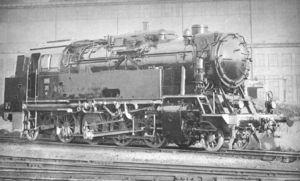BE 31 and 32
| BE 31 and 32 | |
|---|---|
|
Factory photo Krupp
|
|
| Numbering: | BE 31 and 32 |
| Number: | 2 |
| Manufacturer: | Krupp locomotive and wagon construction factory |
| Year of construction (s): | 1950 |
| Retirement: | 1963 |
| Type : | 1'D1 'h2t |
| Genre : | Gt 46.16 |
| Gauge : | 1435 mm ( standard gauge ) |
| Length over buffers: | 14,100 mm |
| Service mass: | 94 t |
| Friction mass: | 64 t |
| Wheel set mass : | 16 t |
| Top speed: | 85 km / h |
| Driving wheel diameter: | 1,350 mm |
| Impeller diameter front: | 850 mm |
| Rear wheel diameter: | 850 mm |
| Boiler overpressure: | 14 bar |
| Grate area: | 3.05 m² |
| Evaporation heating surface: | 196.5 m² |
| Water supply: | 11 m³ |
| Fuel supply: | 3.5 tons of coal |
| Control: | Heusinger |
The BE 31 and 32 were freight tender locomotives that were developed by the Krupp Lokomotiv- und Waggonbaufabrik for the Bentheimer Eisenbahn .
The locomotives were the first brand new steam locomotives to be delivered to private railways after the Second World War . They were created in connection with the procurement of new locomotives for the Deutsche Bundesbahn and only had a relatively short lifespan of around 15 years. It was retired and scrapped in 1963.
development
The Bentheimer Eisenbahn needed after 1949 locomotives stronger than the previously used ELNA locomotives . Based on the experience gained with these locomotives and the BE 41 , Krupp developed a series of types that was specially tailored for service on private railways.
The focus was on lowering the costs of track maintenance through improved running properties, the improved exchange of spare parts between the individual types and the considerably increased tractive power compared to the ELNA locomotives.
The BE ordered two locomotives with the wheel arrangement 1 'D 1' from this program, which were delivered in 1950 and were designated BE 31 and 32 . They were the only locomotives of this series and the last steam locomotives procured by the BE.
technology
The Krupp locomotives were built using the most modern steam locomotive technology of the time. The good running properties, which existed up to the maximum speed in both directions of travel, were achieved by a Krauss-Helmholtz steering frame between the two running axles and the respectively adjacent driving axle.
The high-performance boiler was welded except for the connection seam to the standing boiler and the connections with the steam and feed dome , which were riveted in the usual way. The boiler had a Schmidt-linepipe superheater , a pop safety valve , a fire door of the type Marcotti, a Spindelkipprost, a manual blowdown , two visible water level indicators for the heater as well as the engine driver, an injector of the type Krupp and a mixing preheater of the type Krupp Feed pump.
They each had a particularly large headlight on the smoke chamber door and one at the end of the locomotive with 100 W power, the light intensity could be regulated by the heater through a screen.
commitment
The locomotives fully met the expectations of the Bentheimer Eisenbahn . The service program showed the movement of trains with a load of 1,600 t on the flat at a speed of 40 km / h. Under the most unfavorable friction conditions, a train with a load of 1,200 t on an incline of 10 ‰ was started up without any problems.
The Krupp locomotives were assigned permanent staff. In the event of failure of a train driver, a well-trained stoker with train driver training took over the substitute. When the oil transports at BE came to an end in the early 1960s, no buyers could be found for the locomotives. So they were scrapped in 1963.
literature
- Ludger Kenning: The Bentheim Railway . Kenning Verlag, Nordhorn 1987, ISBN 3-9800952-4-X , p. 56-59 .
Web links
- Company photo of locomotive 32 on the railway foundation
- Company photo of locomotive 31 on the railway foundation
- Website about the locomotives of the Bentheim Railway with mention of the BE 31 and 32
